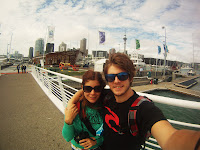Hunua Ranges Regional Park rises from the peripheral towns
of Auckland’s south-east, a bush-covered range of hills mirroring the Waitakere
Ranges that overlook the north-west of the city. Barely half an hour’s drive from
Manukau and through the satellite towns of Papakura and Clevedon, we turned a
corner and laid eyes on the spectacularly inviting turquoise waters and chalky white
coral sand beaches that edge the Firth of Thames. The weather had improved, and
compared with the rugged wind-battered coast of Muriwai and Piha, the body of
water in Kawakawa Bay was a millpond, protected from the open Pacific by the
spinal peaks of the Coramandel Pensinsula on the horizon. We followed the
coastline round, finding more empty picture-perfect beaches, and after
traversing winding climbs and descents worthy of the Tour de France, we eventually
came across a tiny campsite beside the sea, Tapapakanga.
 Auckland’s regional parks are home to an abundance of little
campsites littered amongst the hills and bays. Council-run, they cost $5 - $10
per night and are marvellous little escapist idylls. They’re not manned and
maintained like a private holiday park, and the facilities are rarely beyond a
long-drop and a tap for drinking water, but for small cost we had a beachfront
campsite all to ourselves, barely seeing another soul for two days. An
information board and phone with a direct line to a central office allow you to
make your bookings, before a park ranger does their rounds late in the evening
to ensure visitors have paid for the privilege. People pay thousands – even
millions – on a private beach. We got ours for under £10. Tapakanga beach was
long and white, a thin strip with shallow, clear blue waters one side and
bright red, crumbling cliffs on the other. Giant ancient trees twisted their
way into the rock face, clinging on for dear life, while the bleached skeletal
remains of those trees unlucky to have already collapsed into the sea made the
shoreline look Jurassic. We were in blissful solitude, sharing the beautiful
surroundings with only each other, or so we thought…
Auckland’s regional parks are home to an abundance of little
campsites littered amongst the hills and bays. Council-run, they cost $5 - $10
per night and are marvellous little escapist idylls. They’re not manned and
maintained like a private holiday park, and the facilities are rarely beyond a
long-drop and a tap for drinking water, but for small cost we had a beachfront
campsite all to ourselves, barely seeing another soul for two days. An
information board and phone with a direct line to a central office allow you to
make your bookings, before a park ranger does their rounds late in the evening
to ensure visitors have paid for the privilege. People pay thousands – even
millions – on a private beach. We got ours for under £10. Tapakanga beach was
long and white, a thin strip with shallow, clear blue waters one side and
bright red, crumbling cliffs on the other. Giant ancient trees twisted their
way into the rock face, clinging on for dear life, while the bleached skeletal
remains of those trees unlucky to have already collapsed into the sea made the
shoreline look Jurassic. We were in blissful solitude, sharing the beautiful
surroundings with only each other, or so we thought…
Of all the things we left in the van while she was repaired,
there is one item I bitterly regret forgetting: insect repellent. The local
critters decided to make us acutely aware that we were not alone. After a few
days amidst the wilderness, my feet had amassed a brutal collection of bites. Little
black Sandflies had decimated my lower legs, while mosquitos made short work of
making their presence known. All in all, I had over thirty bites. My blotchy,
swollen feet looked like I was in suffering a bout of syphilis unfortunately
coinciding with elephantiasis. If any of you reading this take only one lesson
home from this entry, let it be this one: Sunscreen will save your life; Insect
repellent will save your sanity. I’ve been itching non-stop since.
It had been a week since the van went back to the garage, so
we called Dave again to see what progress had been made. He confirmed the
worst-case scenario - a blown head
gasket – but assured us that the van would be ready for the following day. We
spent the next night amongst the rolling bush of Hunua Ranges park, again with
a campsite to ourselves, and visited nearby Hunua Falls the next morning. Sure
enough we had the van back by the afternoon.
Sadly, I’d missed out on the travel writer opportunity in
Napier, but I wasn’t resentful. We had no commitments again, so after a moment
of deliberation we decided our next stop should be the steamy thermal town of Rotorua,
and finally hit the road.







